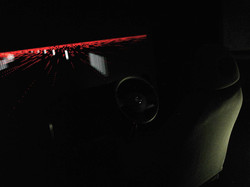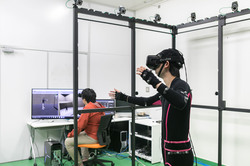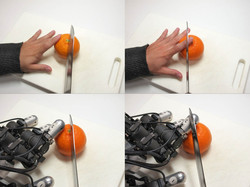
Kitazaki, Michiteru
| Affiliation | Department of Computer Science and Engineering |
|---|---|
| Title | Professor |
| Fields of Research | Perceptual Psychology / Cognitive Neuroscience / Virtual Reality |
| Degree | PhD (University of Tokyo) |
| Academic Societies | Japanese Psychological Association / Virtual Relity Society of Japan / Vision Society of Japan / Japanese Psychonomic Society / Vision Sciences Society |
| mich@cs Please append ".tut.ac.jp" to the end of the address above. |
|
| Laboratory website URL | http://real.cs.tut.ac.jp/ |
| Researcher information URL(researchmap) | Researcher information |
Research
We aim to understand scientifically how we perceive the world/environment and communicate with others. Embodied perception is a main perspective in our research. Our perceptual process and communication are crucially connected to our body physically and psychologically. We are investigating three research themes based on this perspective.
- Science for Mobile Observers
- Science for Embodied Reality
- Science for Implicit Social Cognition
Human body and our body scheme are changing with virtual reality technology and robotics. We investigate how our mind, behavior and societal issues change by modifed and new bodies in the real or virtual world. It contributes to designing the future society.
Theme1:Science for Mobile Observer
Overview
To understand perception for mobile observers, we are investigating self-motion perception, 3-D perception, scene and human-body recognition across viewpoints with psychophysical experiments. To know interaction of perception and action, we are measuring motor behavior and perception during action such as walking and driving a car. Parts of driving study are cooperative studies with motor companies. We are developing a system to experience tele-presence of walking using virtual reality.
Selected publications and works
Nakamura, J., and Kitazaki, M. (2024). The effect of posture on virtual walking experience using foot vibrations, Scientific Reports, 14:19366
Nakamura, J., Ikei, Y., and Kitazaki, M. (2024). Effects of foot vibration and self-avatar cast shadow on virtual walking sensations and cybersickness from omnidirectional movie. i-Perception,15(1):20416695241227857
Nakamura, J., Matsuda, Y., Amemiya, T., Ikei, Y., and Kitazaki, M. (2021). Virtual Walking with Omnidirectional Movies and Foot Vibrations: Scene-congruent Vibrations Enhance Walking-related Sensations and Ground Material Perceptions. IEEE Access, DOI: 10.1109/ACCESS.2021.3136557
Matsuda, Y., Nakamura, J., Amemiya, T., Ikei, Y., and Kitazaki, M. (2021). Enhancing Virtual Walking Sensation using Self-Avatar in First-person Perspective and Foot Vibrations, Frontiers in Virtual Reality, 2:654088
Matsuda, Y., Sugimoto, M., Inami, M., and Kitazaki, M. (2021). Peripersonal space in the front, rear, left and right directions for audio-tactile multisensory integration. Scientific Reports, 11:11303
Kitazaki, M., Hamada, T., Yoshiho, K., Kondo, R., Amemiya, T., Hirota, K., and Ikei, Y. (2019). Virtual walking sensation by pre-recorded oscillating optic flow and synchronous foot vibration. i-Perception, 10(5), 1–14. doi:10.1177/2041669519882448
Amemiya, T., Ikei, Y., and Kitazaki, M. (2019). Remapping peripersonal space by using foot sole vibrations without any body movement. Psychological Science, https://doi.org/10.1177/0956797619869337
Kitazaki, M. (2013), Effects of retinal position on visuo-motor adaptation of visual stability in a virtual environment, i-Perception, 4(4), 242-252.
Kawahara, J., Yanase, K., and Kitazaki, M. (2012), Attentional capture by the onset and offset of motion signals outside the spatial focus of attention, Journal of Vision, 12(12): 10.
Kitazaki, M. and Kimura, T. (2010), Effects of long-term adaptation to sway-yoked visual motion and galvanic vestibular stimulation on visual and vestibular control of posture, Presence: Teleoperators and Virtual Environments, 19(6), 544-556.
Kitazaki, M. and Sato, T. (2003), Attentional modulation of self-motion perception, Perception, 32, 475-484.
Keywords
Theme2:Science for Embodied Reality
Overview
To know what is realty, we are focusing on body perception, body ownership, and self-agency. Perceptual reality must be based on our body and its perception. We are investigating material perception, perceptual aesthetics, lightness perception, self-motion perception, human-body perception, and augmented human in virtual-reality environments. Cross-modal studies such as vision-vestibular interaction on postural control and face-voice interaction on emotions are included in the theme. We are modifying human body appearance and function using virtual reality to see how human mind and behavior change in such modified bodies.
Selected publications and works
Hapuarachchi, H., Ishimoto, H., Kitazaki, M., Sugimoto, M., Inami, M. (2023). Temporal visuomotor synchrony induces embodiment towards an avatar with biomechanically impossible arm movements, i-Perception, 14(6):20416695231211699
Katsumata, Y., Inoue, Y., Toriumi, S., Ishimoto, H., Hapuarachchi, H., and Kitazaki, M. (2023). Shared avatar for hand movement imitation: Subjective and behavioral analyses. IEEE Access, 11, 96710-96717.
Hapuarachchi, H., Hagiwara, T., Ganesh, G., and Kitazaki, M. (2023). Effect of connection induced upper body movements on embodiment towards a limb controlled by another during virtual co-embodiment. PLoS One, 18(1): e0278022
Hapuarachchi H., and Kitazaki, M. (2022). Knowing the intention behind limb movements of a partner increases embodiment towards the limb of joint avatar, Scientific Reports, 12:11453
Arai, K., Saito, H., Fukuoka, M., Ueda, S., Sugimoto, M., Kitazaki, M., and Inami, M. (2022). Embodiment of Supernumerary Robotic Limbs in Virtual Reality, Scientific Reports, 12: 9769
Miura, R., Kasahara, S., Kitazaki, M., Verhulst, A., Inami, M., and Sugimoto, M. (2022). MultiSoma: Motor and Gaze Analysis on Distributed Embodiment with Synchronized Behavior and Perception. Frontiers in Computer Science, 4:788014
Hagiwara, T., Ganesh, Sugimoto, M., Inami, M., and Kitazaki, M. (2020) Individuals prioritize the reach straightness and hand jerk of a shared avatar over their own, iScience, 23(12): 101732
Kondo, R., Tani, Y., Sugimoto, M., Inami, M., and Kitazaki, M. (2020). Scrambled body differentiates body part ownership from the full body illusion. Scientific Reports, 10:5274,
Kondo, R., Tani, Y., Sugimoto, M., Minamizawa, K., Inami, M., and Kitazaki, M. (2020). Re-association of Body Parts: Illusory Ownership of a Virtual Arm Associated with the Contralateral Real Finger by Visuo-motor Synchrony. Frontiers in Robotics and AI: Virtual Environments, 7:26.
Kondo, R., Sugimoto, M., Minamizawa, K., Hoshi, T., Inami, M., and Kitazaki, M. (2018). Illusory body ownership of an invisible body interpolated between virtual hands and feet via visual-motor synchronicity, Scientific Reports, 8:7541
Keywords
Theme3:Science for Implicit Social Cognition
Overview
We interact with others naturally, and perceive the world and others based on social communications. The crucial factor for implicit social cognition is our body. We are investigating body perception, neurophysiology of empathy, equity, and moral. We found that the preverbal infants show sympathy for others in distress and that humans can empathize with humanoid robots. We focued on social interactions not only in the real world but also in the rapidly spreading metaverse.
Selected publications and works
Hapuarachchi, H., Higashihata, K., Sugiura, M., Sato, A., Itakura, S., and Kitazaki, M. (2023). Empathic embarrassment towards non-human agents in virtual environments, Scientific Reports, 13: 13914
Sato, A., Matsuo, A., and Kitazaki, M. (2019). Social contingency modulates the perceived distance between self and other. Cognition, 192, 1-5. doi: 10.1016/j.cognition.2019.06.018
Kenward, B., Berggren, M., Kitazaki, M., Itakura, S., and Kanakogi, Y. (2018). Implicit social associations for geometric shape agents more strongly influenced by visual form than by explicitly identified social actions. Psychologia, 61(1), 37-52
Ishikawa, M., Park, Y-h., Kitazaki, M., and Itakura, S. (2017). Social information affects adults’ evaluation of fairness in distributions: An ERP approach. PLoS ONE, 12(2): e0172974
Suzuki, Y., Galli, L., Ikeda, A., Itakura, S. and Kitazaki, M. (2015). Measuring empathy for human and robot hand pain using electroencephalography. Scientific Reports, 5:15924
Kanakogi, Y., Okumura, Y., Inoue, Y., Kitazaki, M., and Itakura, S. (2013), Rudimentary sympathy in preverbal infants: Preference for others in distress, PLOS ONE, 8(6): e65292.
Keywords
Title of class
Introduction in Cognitive Sciences / Human Information Processing / X Reality and Psychology
Others (Awards, Committees, Board members)
JVRC2009 (2009 Joint Virtual Reality Conference of EGVE - ICAT - EuroVR) Best Paper Award Honorable Mention(2009)
Best paper award of Transactions of Virtual Reality Society of Japan (2006, 2010, 2014, 2017)
Best paper award of Japanese Journal of Psychonomic Science (2014)
Best demo award of Augmented Human 2017
SIGGRAPH Asia 2018 Best Virtual Reality and Augmented Reality Award (2018)
Scientific Reports Top 100 in Neuroscience 2018 (2019)
Augmented Humans 2021, Best Paper Award
Augmented Humans 2022, Best Paper Award Honorable Mention
Japan Psychological Association: 2005-now Representative
Virtual Reality Society of Japan: 2011-2014, 2021-2024 Executive board member
SIG for Virtual-Reality Psychology: 2009-2011 SIG Chair
SIG for Augmented Cognition Interface: 2018-now SIG Chair
Senior Science and Technology Policy Fellow, Council for Science, Technology and Innovation, Cabinet Office, Government of Japan (2016)




